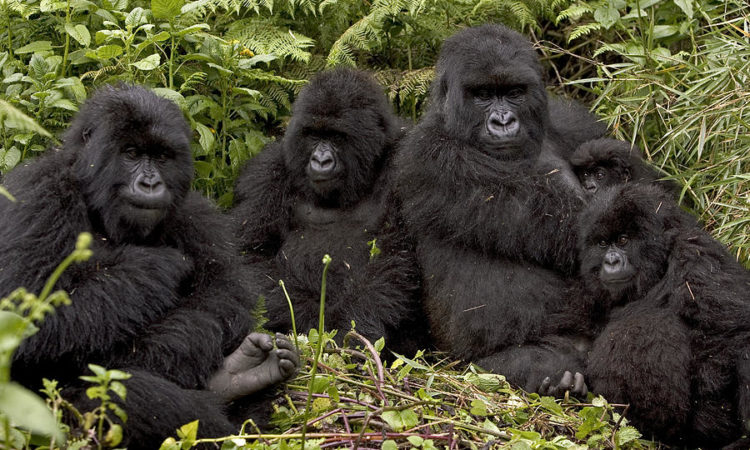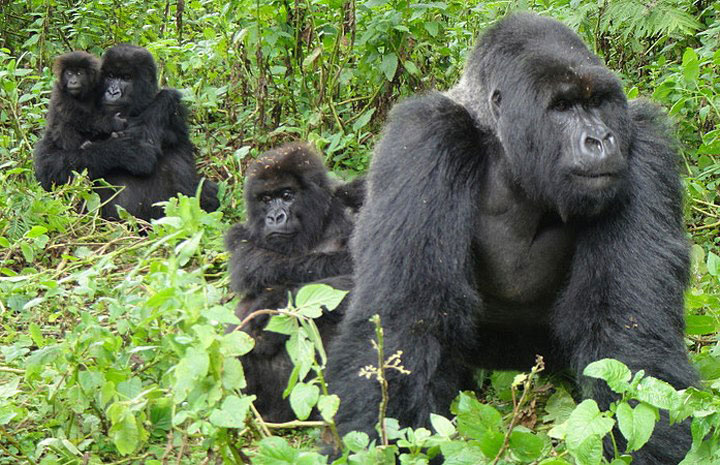Mountain Gorilla Habitat: A Fragile Sanctuary in the Heart of Africa
Mountain Gorilla Habitat: In the misty, high-altitude forests of Central Africa, the mountain gorilla (Gorilla beringei beringei) thrives in one of the world’s most unique and endangered ecosystems.
These majestic primates, among the closest relatives to humans, inhabit a delicate landscape of montane cloud forests, bamboo groves, and subalpine zones, nestled within the volcanic Virunga Massif and Uganda’s Bwindi Impenetrable National Park.
In this comprehensive guide, we explore the intricate details of their habitat, from its lush biodiversity and ecological dynamics to the pressing threats it faces, such as deforestation, poaching, and climate change.
By understanding this fragile sanctuary, we uncover the challenges and triumphs of conserving a species teetering on the edge of extinction, highlighting the urgent need to protect their irreplaceable home.
Geographical Range and Distribution of a Mountain Gorilla Habitat
Mountain gorillas are found in two isolated populations in Central Africa, both situated in high-altitude montane and bamboo forests. The first population resides in the Virunga Massif, a volcanic mountain range spanning the borders of Rwanda, Uganda, and the Democratic Republic of Congo (DRC).
This region encompasses Rwanda’s Volcanoes National Park, Uganda’s Mgahinga Gorilla National Park, and the DRC’s Virunga National Park.
The second population inhabits Bwindi Impenetrable National Park in southwestern Uganda, with a small number potentially extending into the adjacent Sarambwe Nature Reserve in the DRC.
The Virunga Massif covers approximately 447 square kilometers, while Bwindi spans about 331 square kilometers. These areas are characterized by rugged terrain, steep slopes, and elevations ranging from 1,800 to 4,500 meters above sea level.
The high altitude and unique topography create distinct microclimates that define the mountain gorilla habitat, providing both challenges and opportunities for their survival.

Ecological Characteristics of the Mountain Gorilla Habitat
Mountain gorilla habitats are primarily montane cloud forests, bamboo forests, and subalpine zones, each offering a unique set of resources critical to the gorillas’ survival.
These ecosystems are shaped by high rainfall, cool temperatures, and rich volcanic soils, which support dense vegetation and a diverse array of flora.
Montane Cloud Forests
The core of the mountain gorilla’s habitat is the montane cloud forest, found at elevations between 2,200 and 3,500 meters. These forests are perpetually shrouded in mist, earning the nickname “cloud forests.”
The high humidity and frequent rainfall (up to 2,000 mm annually) create lush, verdant environments dominated by broad-leaved trees, epiphytes, and ferns. Common tree species include Hagenia abyssinica and Hypericum revolutum, which form dense canopies that provide shade and protection.
The forest floor is covered with herbaceous plants, such as wild celery (Peucedanum linderi), thistles, and nettles, which are staples in the mountain gorilla’s diet.
The dense undergrowth also offers nesting materials, as gorillas construct nightly sleeping platforms from branches and leaves. The cloud forest’s cool temperatures, ranging from 5°C to 20°C, suit the gorillas’ thick fur, which insulates them against the cold.
Bamboo Forests
At lower elevations (1,800–2,500 meters), particularly in the Virunga Massif, bamboo forests dominate. Species like Arundinaria alpina provide a critical food source, as mountain gorillas consume bamboo shoots, leaves, and stems during certain seasons.
Bamboo forests are less dense than cloud forests, allowing more sunlight to penetrate and fostering a different set of plant species.
The gorillas’ ability to exploit bamboo as a seasonal resource demonstrates their adaptability to varying ecological conditions within their habitat.
Subalpine and Alpine Zones
At higher elevations (3,500–4,500 meters), the habitat transitions into subalpine and alpine zones, particularly in the Virunga Massif. These areas feature open meadows, giant lobelias, and senecios, with sparse vegetation due to colder temperatures and thinner soils.
While gorillas occasionally venture into these zones, they primarily remain in the lower, forested areas where food and shelter are more abundant.
However, these high-altitude zones contribute to the overall biodiversity of the region and serve as a buffer against human encroachment.
Biodiversity and Ecological Interactions
The mountain gorilla’s habitat is a biodiversity hotspot, supporting a wide range of flora and fauna that interact with the gorillas in complex ways.
The forests are home to numerous plant species, including over 200 tree species in Bwindi alone, as well as ferns, mosses, and orchids.
This botanical diversity ensures a steady supply of food for the herbivorous gorillas, who consume up to 30 kilograms of vegetation daily.
Other wildlife in the habitat includes golden monkeys (Cercopithecus mitis kandti), forest elephants, buffalo, and various antelope species like the bushbuck.
Mountain gorilla Predators such as leopards are present but pose little threat to adult gorillas due to their size and social structure. Smaller mammals, birds (over 300 species in Bwindi), and insects contribute to the ecosystem’s complexity, with pollinators and seed dispersers playing critical roles in maintaining forest health.
Mountain gorillas themselves are ecosystem engineers. Their foraging behavior shapes the forest by creating clearings, promoting plant regeneration, and aiding seed dispersal through their feces.
Their nests, built nightly, contribute organic matter to the soil, enhancing nutrient cycling. These interactions underscore the gorillas’ role as a keystone species, whose presence supports the broader ecological balance.

Climate and Environmental Conditions
The mountain gorilla’s habitat is defined by its high-altitude, tropical climate. Annual rainfall ranges from 1,500 to 2,000 mm, with two wet seasons (March–May and September–November) and two dry seasons.
The wet seasons promote lush vegetation growth, ensuring ample food, while dry seasons may limit certain resources like bamboo shoots, prompting gorillas to adjust their ranging patterns.
Temperatures in the habitat are cool, averaging 10–15°C, with occasional drops to near-freezing at higher elevations. The volcanic soils, enriched by past eruptions, are highly fertile, supporting dense vegetation.
However, the steep terrain and high humidity make the habitat challenging for both gorillas and humans, with muddy trails and dense undergrowth complicating movement.
Threats to the Mountain Gorilla Habitat
Despite its ecological richness, the mountain gorilla’s habitat faces significant threats, primarily driven by human activities and environmental changes. These threats jeopardize not only the gorillas but the entire ecosystem.
Habitat Loss and Fragmentation
Agricultural expansion and deforestation pose the greatest risks. The human population surrounding the gorilla habitats, particularly in Rwanda and the DRC, relies heavily on subsistence farming.
Clearing forests for farmland reduces the gorillas’ range and fragments their habitat, isolating populations and limiting genetic diversity.
In the DRC, illegal logging and charcoal production further degrade the forests, particularly in Virunga National Park.
Poaching and Illegal Activities
While direct poaching of mountain gorillas has decreased due to conservation efforts, illegal hunting of other species (e.g., bushmeat) disrupts the ecosystem.
Snares set for smaller animals can injure gorillas, and the presence of poachers increases human-wildlife conflict. Additionally, illegal resource extraction, such as mining in the DRC, fragments habitats and pollutes water sources.
Climate Change
Climate change is an emerging threat, altering rainfall patterns and temperatures in the gorilla’s habitat. Prolonged dry seasons may reduce food availability, while increased rainfall could lead to landslides on steep slopes.
Shifts in vegetation zones due to warming temperatures may force gorillas to higher elevations, where food is scarcer. These changes could also affect the availability of bamboo, a key seasonal resource.
Human-Wildlife Conflict
As human populations encroach on gorilla habitats, conflicts arise. Gorillas occasionally raid crops, leading to retaliation from farmers.
Disease transmission is another concern, as humans and gorillas share susceptibility to respiratory illnesses. For example, human colds or flu can be deadly to gorillas, whose immune systems are not adapted to such pathogens.
Conservation Efforts and Successes
The mountain gorilla’s survival is a testament to decades of dedicated conservation work. Organizations like the Dian Fossey Gorilla Fund, World Wildlife Fund (WWF), and local governments have implemented strategies to protect the habitat and its inhabitants.
Protected Areas and Law Enforcement
The establishment of national parks—Volcanoes, Mgahinga, Virunga, and Bwindi—has been critical. These protected areas are patrolled by rangers who combat poaching, remove snares, and monitor gorilla groups. In Rwanda, revenue from gorilla tourism funds ranger training and community development, creating incentives for local support.
Gorilla Tourism
Gorilla trekking tourism, particularly in Rwanda and Uganda, generates significant revenue, with permits costing $800–$1,500 per person.
This income supports conservation programs and provides economic benefits to local communities, reducing reliance on forest resources.
Strict regulations, such as limiting tourist group sizes and maintaining a 7-meter distance from gorillas, minimize disturbance and disease transmission.
Community Engagement
Engaging local communities is key to conservation success. Programs provide alternative livelihoods, such as beekeeping or handicraft production, to reduce dependence on farming.
Education initiatives raise awareness about the ecological and economic value of gorillas, fostering a sense of stewardship.
In Rwanda, the annual Kwita Izina gorilla-naming ceremony celebrates conservation achievements and involves local communities.
Population Recovery
Conservation efforts have yielded remarkable results. In the 1980s, the mountain gorilla population was critically endangered, with fewer than 300 individuals.
By 2025, the population has grown to over 1,000, according to estimates from the International Gorilla Conservation Programme (IGCP).
This recovery is attributed to habitat protection, anti-poaching measures, and veterinary interventions, such as treating injured gorillas.
Challenges and Future Directions
Despite progress, challenges remain. Political instability in the DRC, particularly in Virunga National Park, complicates conservation efforts, as armed conflicts disrupt patrols and endanger rangers.
Balancing tourism with gorilla welfare is another concern, as increased human presence could stress gorilla groups or introduce diseases.
Future conservation strategies must address climate change through adaptive management, such as restoring degraded habitats and creating wildlife corridors to connect fragmented forests.
Strengthening regional cooperation among Rwanda, Uganda, and the DRC is essential for managing transboundary habitats.
Additionally, investing in renewable energy and sustainable agriculture can reduce pressure on forests while supporting local economies.
Conclusion
The mountain gorilla’s habitat is a remarkable ecosystem, defined by its lush forests, diverse flora and fauna, and complex ecological interactions.
While threats like habitat loss, poaching, and climate change persist, conservation efforts have demonstrated that recovery is possible.
The mountain gorilla’s story is one of resilience, highlighting the power of collective action to protect a species and its home.
By continuing to prioritize habitat preservation, community engagement, and sustainable tourism, we can ensure that this fragile sanctuary endures for future generations, safeguarding not only the mountain gorilla but the rich biodiversity of Central Africa’s montane forests.
